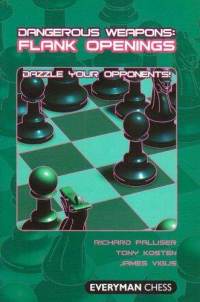Dangerous Weapons — Flank Openings
James Vigus, John Emms, Richard Palliser

Everymans Dangerous Weapon series continues it successful run with its latest offering, Dangerous Weapons: Flank Openings by IM Richard Palliser, GM John Emms and FM James Vigus.
The present work is primarily devoted to the English with seven of the twelve chapters dedicated to it. This includes coverage of the old Nimzovich favorite 1.c4 e5 2.Nc3 Nf6 3.Nf3 Nc6 4.e4 and two chapters and over 40 pages to lines after 1.c4 e5 2.g3 where Black opts for a quick c6. Another two chapters are devoted to the Mikenas attack (1.c4 Nf6 2.Nc3 e6 3.e4) where both of Blacks two tries 3 …c5 and 3 …d5 are examined at length. Coverage of the English concludes with two chapters on the Symmetrical Variation where White plays an early d4 1.c4 c5 2.Nf3 Nc6 3.d4 cxd4 4.Nxd4 e5!? 5. Nb5 a6 and 1.c4 c5 2.Nf3 Nf6 3.d4 cxd4 4.Nxd4 e5!? 5. Nb5 d5 6.cxd5 Bc5.
Players who like to open 1.Nf3 have to make a choice after 1 d5. Some are content to follow Kramnik and play 2.d4, seeing themselves as Queen pawn players who have avoided some of the sharper tries after 1.d4 like the Grunfeld, Modern Benoni, Benko Gambit and Budapest. Other 1.Nf3 aficionados, like Vaganian, prefer to sidestep the massive theory of the Queens Gambit complex and opt for 2.g3. They do so aiming for a familiar middlegame position rather than an opening advantage. Lastly there are those that follow in Retis footsteps and commence 1.Nf3 d5 2.c4.
This sequence has been unpopular for some time for two reasons. One is after 2 dxc4 it has long been held that White has nothing better than 3.e3 transposing to the Queens Gambit Accepted, which enjoys a justly deserved reputation as a tough nut to crack. Many players who open 1.Nf3 and have experience with 1.d4 count the avoidance of the QGA as yet another reason for trotting out their Knight on move one. However, for many this means playing the Kings Indian Attack or Reti double fianchetto setups that objectively dont promise a lot.
The second problem is 1.Nf3 d5 2.c4 d4. Kortchnoi considers Whites second move to be a mistake and Black to stand better after 2 …d4. Space may not be the final frontier but there can be little doubt that Viktor Lvovich puts a high premium on it.
GM Tony Kosten challenges conventional wisdom with his advocacy of the forgotten idea 1.Nf3 d5 2.c4 dxc4 3.e4 c5 (the most challenging response to 3.e4) 4.Bxc4 Nc6 5.b4!?, first used by American master George Kramer against Reuben Fine in 1948.
Kosten also supports the plan concocted by American GM Fishbein, possibly over the board, against IM Dmitry Schneider in the 2004 US Championship 1.c4 e6 2.Nf3 d5 3.b3 Nf6 4.g3 c5 5.Bg2 Nc6 6.0-0 d4 7.e3 Be7 8.exd4 cxd4 9.Bb2 0-0 10.Re1 Ne8 11.Ne5 Nxe5 12. Rxe5 f6 13.Re1 e5 14.f4! exf4 15.Qf3!
Dangerous Weapons: Flank Openings concludes with an anti-Slav/semi-Slav chapter that can be used by both English and 1.Nf3 players (White holds back d4 by opening Nf3, c4, Nc3 and e3), and two chapters on the Bird. The first is on Larsens antidote to the From Gambit (1.f4 e5 2.fxe5 d6 3.exd6 Bxd6 4.Nf3 Nf6 5.Nc3), the second is on the Polar Bear, what GM Henrik Danielsen calls his pet system arising after 1.f4 d5 2.Nf3 g6 3.g3 Bg7 4.Bg2 Nf6 5.0-0 0-0 6.d3 c5 7.c3 Nc6 8.Na3.
Those who open 1.Nf3, 1.c4 or 1.f4 will find plenty of food for thought in Dangerous Weapons: Flank Openings.
